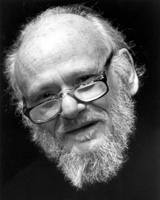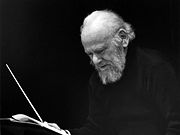
Ralph Shapey
Encyclopedia

United States
The United States of America is a federal constitutional republic comprising fifty states and a federal district...
composer
Composer
A composer is a person who creates music, either by musical notation or oral tradition, for interpretation and performance, or through direct manipulation of sonic material through electronic media...
and conductor
Conducting
Conducting is the art of directing a musical performance by way of visible gestures. The primary duties of the conductor are to unify performers, set the tempo, execute clear preparations and beats, and to listen critically and shape the sound of the ensemble...
. He is well-known for his work as a composition professor at the University of Chicago
University of Chicago
The University of Chicago is a private research university in Chicago, Illinois, USA. It was founded by the American Baptist Education Society with a donation from oil magnate and philanthropist John D. Rockefeller and incorporated in 1890...
, where he founded and directed the Contemporary Chamber Players. Shapey was a MacArthur Fellow
MacArthur Fellows Program
The MacArthur Fellows Program or MacArthur Fellowship is an award given by the John D. and Catherine T...
in 1982.
Although Shapey's style is characterized by angularity, irony, and technical rigor, it eschews the pointillism
Punctualism
Punctualism is a style of musical composition prevalent in Europe between 1949 and 1955 "whose structures are predominantly effected from tone to tone, without superordinate formal conceptions coming to bear"...
, anti-emotionalism, and detached austerity of much twelve-tone
Twelve-tone technique
Twelve-tone technique is a method of musical composition devised by Arnold Schoenberg...
music. His work's insistence instead on sweeping gesture, frenetic passion, rhythmic vitality, lyrical melody, and dramatic arc recall Romanticism
Romanticism
Romanticism was an artistic, literary and intellectual movement that originated in the second half of the 18th century in Europe, and gained strength in reaction to the Industrial Revolution...
. Shapey was dubbed by critics Leonard Meyer and Bernard Jacobson as a "radical traditionalist," which pleased him immensely -- he held a deep respect for the masters of the past, whom he regarded as his finest teachers.
The French-American composer Edgard Varèse
Edgard Varèse
Edgard Victor Achille Charles Varèse, , whose name was also spelled Edgar Varèse , was an innovative French-born composer who spent the greater part of his career in the United States....
was among Shapey's most important influences. Both composers shared a fascination with unusual sonorities, counterpoint
Counterpoint
In music, counterpoint is the relationship between two or more voices that are independent in contour and rhythm and are harmonically interdependent . It has been most commonly identified in classical music, developing strongly during the Renaissance and in much of the common practice period,...
masses, and the outer extremes of pitch space
Pitch space
In music theory, pitch spaces model relationships between pitches. These models typically use distance to model the degree of relatedness, with closely related pitches placed near one another, and less closely related pitches placed farther apart. Depending on the complexity of the relationships...
. The coordination of static "sound blocks" in Shapey's music also reminds one of another great French composer, Olivier Messiaen
Olivier Messiaen
Olivier Messiaen was a French composer, organist and ornithologist, one of the major composers of the 20th century. His music is rhythmically complex ; harmonically and melodically it is based on modes of limited transposition, which he abstracted from his early compositions and improvisations...
, though Shapey reportedly found Messiaen's music saccharine and maudlin. Shapey also studied with Stefan Wolpe
Stefan Wolpe
Stefan Wolpe was a German-born composer.-Life:Wolpe was born in Berlin. He attended the Klindworth-Scharwenka Conservatory from the age of fourteen, and the Berlin Hochschule für Musik in 1920-1921. He studied composition under Franz Schreker and was also a pupil of Ferruccio Busoni...
.
Although comparisons are useful, Shapey's compositional voice is undoubtedly personal and distinctive. Many listeners would call his music "atonal," but Shapey himself denied the label. He considered himself a tonal
Tonality
Tonality is a system of music in which specific hierarchical pitch relationships are based on a key "center", or tonic. The term tonalité originated with Alexandre-Étienne Choron and was borrowed by François-Joseph Fétis in 1840...
composer, and indeed his work, though couched in a highly dissonant harmonic idiom rich in interval class
Interval class
In musical set theory, an interval class , also known as unordered pitch-class interval, interval distance, undirected interval, or interval mod...
es 1 and 6, does adhere to certain organizational features of tonal music, including pitch hierarchy and object permanence
Object permanence
Object permanence is the understanding that objects continue to exist even when they cannot be seen, heard, or touched. It is acquired by human infants between 8 and 12 months of age via the process of logical induction to help them develop secondary schemes in their sensori-motor coordination...
.
In 1992 the Pulitzer Prize for Music
Pulitzer Prize for Music
The Pulitzer Prize for Music was first awarded in 1943. Joseph Pulitzer did not call for such a prize in his will, but had arranged for a music scholarship to be awarded each year...
jury, which that year consisted of George Perle
George Perle
George Perle was a composer and music theorist. He was born in Bayonne, New Jersey. Perle was an alumnus of DePaul University...
, Roger Reynolds
Roger Reynolds
Roger Reynolds is an American composer born July 18, 1934 in Detroit, Michigan. He is a professor at the University of California at San Diego. He received an undergraduate degree in engineering physics from the University of Michigan where he later studied composition with Ross Lee Finney...
, and Harvey Sollberger
Harvey Sollberger
Harvey Sollberger is an American composer, flutist, and conductor specializing in contemporary classical music.-Life:...
, selected Shapey's "Concerto Fantastique" for the award. However, the Pulitzer Board rejected that decision and choose to give the prize to the jury's second choice, Wayne Peterson
Wayne Peterson
Wayne Peterson is a Pulitzer Prize winning composer, as well as a pianist and educator.Peterson earned B.A., M.A., and Ph.D. degrees at the University of Minnesota...
. The music jury responded with a public statement stating that they had not been consulted in that decision and that the Board was not professionally qualified to make such a decision. The Board responded that the "Pulitzers are enhanced by having, in addition to the professional's point of view, the layman's or consumer's point of view," and they did not rescind their decision. http://www.american.edu/heintze/Pul1.htm
Shapey created a body of over 200 works, many of which have been published by Presser. Presser also offers his textbook
A Basic Course in Music Composition, written after over fifty years of teaching the subject. Recordings of Shapey's music are available on the CRI, Opus One, and New World labels. Shapey's works have been catologued by Dr. Patrick D. Finley in A Catalogue of the Works of Ralph Shapey, published by Pendragon Press
His students include Gerald Levinson
Gerald Levinson
Gerald Levinson is an American composer of contemporary classical music.-Life:At university, he studied with George Crumb, Richard Wernick, and George Rochberg. After college, Levinson went to study composition with Olivier Messiaen at the Paris Conservatory...
, Robert Carl
Robert Carl
Robert Carl is an American composer who currently resides in Hartford, Connecticut, where he is chair of the composition department at the Hartt School of Music, University of Hartford.-Music:...
, Gordon Marsh, Michael Eckert, Matt Malsky, Lawrence Fritts, James Anthony Walker, Frank Retzel, Jorge Liderman, Jonathan Elliott, Deborah Drattell, Ursula Mamlok
Ursula Mamlok
Ursula Mamlok is a German-born, American composer and teacher.-Education and influences:Mamlok was born as Ursula Meyer in Berlin, Germany and studied piano and composition with Professor Gustav Ernest and Emily Weissgerber until her family fled Nazi Germany following the nationwide pogrom in 1938...
, Shulamit Ran
Shulamit Ran
Shulamit Ran is an Israeli-American composer. She moved from Israel to New York at 14, as a scholarship student at the Mannes College of Music. Her Symphony won her the Pulitzer Prize...
, Terry Winter Owens, and a very broad and exceptional list of others.
The composer Robert Black
Robert Black (conductor)
Note: Not to be confused with the saxophonist or the double-bass player named Robert Black.Robert Carlisle Black was an American conductor, pianist and composer...
was particularly influenced by him, and as a conductor he also premiered Shapey's Three for Six.
Statement by Ralph Shapey about his work

My credo is: 1) The music must speak for itself. 2) Great art is a miracle. 3) What the mind can conceive will be done."
Sources
- Carl, Robert "Radical Traditionalism". Liner notes to Ralph Shapey - Radical Traditionalism. New World Records.
- Kozinn, Allan. "Ralph Shapey, 81, Composer Evoking Conflicting Impulses" The New York Times (June 14, 2002)
External links
- Presser Online Composer Information - Ralph Shapey
- Bierce Library at University of Akron: Smith Archives - Composer Profile of Ralph Shapey
- University of Chicago News Office - Obituary for Ralph Shapey
- The Musical Times - In Memoriam Ralph Shapey
- Art of the States: Ralph Shapey 21 Variations (1978) performance, essay, and podcast by pianist David Holzman

